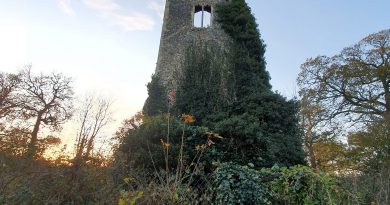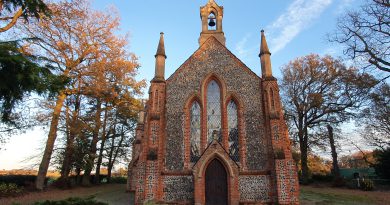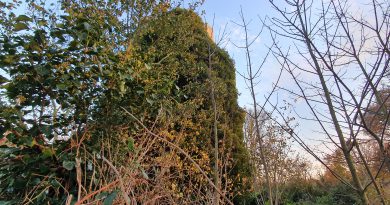Hainford – All Saints Church (the old one)
This is the old All Saints church in Hainford, with a replacement new building having opened in 1840 about half a mile away, nearer to where the new community was located. There was a fear that congregations might flock to alternative Christian churches and indeed, near to the new church the Wesleyan Methodist Chapel was being built. So, this old church was abandoned.
This ivy and tree foliage means that this glorious church is likely now in its death throes, it’ll last for some time yet, but the damage being done here will eventually be fatal for the structure of the tower.
The damage being done to the building is evident, with missing stones and foliage which is firmly attached to the church.
And the tower, which dates to the late fifteenth century, is also slowly starting to fall down. The old line of the nave roof is still visible and underneath that is where the Victorian mortuary chapel was added after the former section of nave was removed.
This tombstone is from the seventeenth century and this is an incredibly rare sight in a Norfolk graveyard, as even eighteenth century gravestones are relatively rare. But, this stone was once inside the church and is lined up with where the nave of the church once stood. I’m not sure what William would have thought of this, he was likely a rich benefactor who thought his body would remain inside the church forever, not end up like this.
All around the tower is foliage, it hides the mortuary chapel which John Brown added here. It’s not clear exactly when the nave and chancel were removed, but I imagine that it was removed around 1840 under the supervision of Brown, if it’s correct that he was in charge of adding the mortuary chapel. It also seems that some nearby buildings use stone from the old church, so this must have been flogged off at the time (or recycled, whichever word you prefer).
This church remained in use until the new one was opened in 1840 and the graveyard here is still in situ. There’s a better photo of the mortuary chapel, by the wonderful George Plunkett, which was taken in 1965.
The comments from the internal report by the Church of England, noting Brown’s mortuary chapel which was added on to where the nave once stood. This internal note also mentions something else interesting, relating to the foundations of St. Mary’s Church in Hainford, which was once in the same location. At a quick glance, I can’t find out anything about this (and the old tithe maps give no clues), but it might solve a mystery about why the churchyard is so large.
I usually like the idea of restoring churches, although the Church of England seems to have muddled views on this. It’ll spend a fortune fiddling about with using the exact stones on a window repair, but then abandon a building a few years later if it suits them to do so. I’m thinking about Bixley Church here….. The collapse of churches such as Bixley and Sco Ruston is recent though, the damage done at Hainford is getting on for two centuries ago. It would be ludicrously expensive for this church to be repaired, even restored to the basic tower that there is at Panxworth, so this will always be a ruin. But, it’s still beautiful and I very much like it, and although it’s not ideal that nature is overtaking the structure, it does give it even more character.











